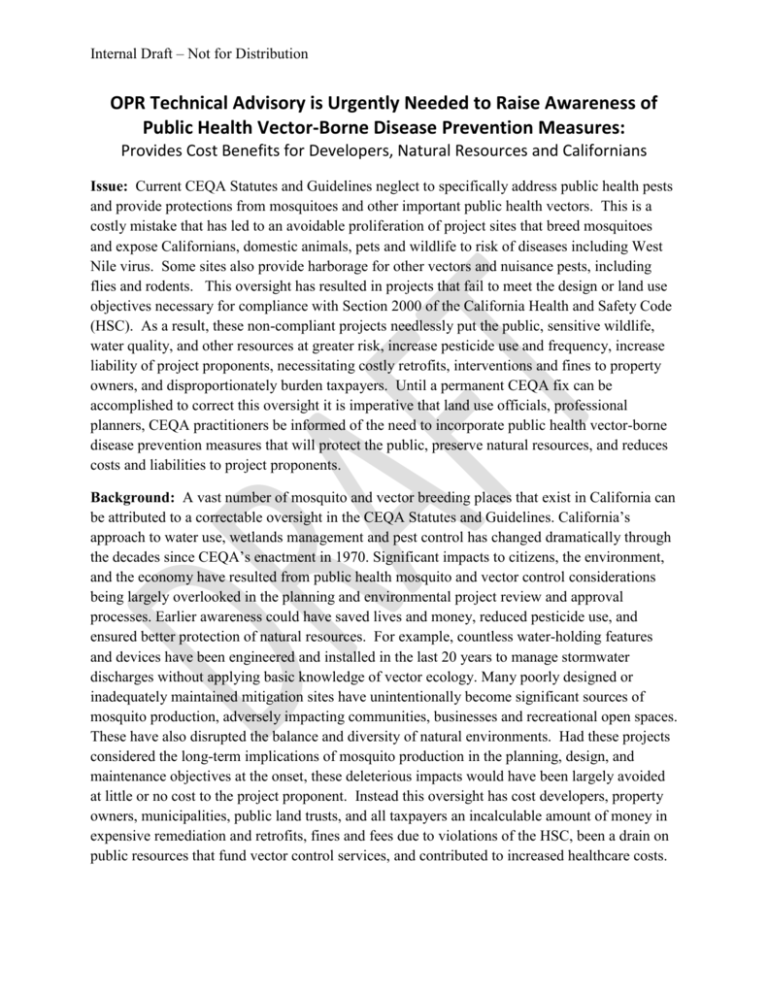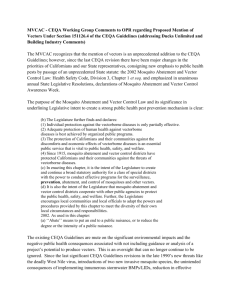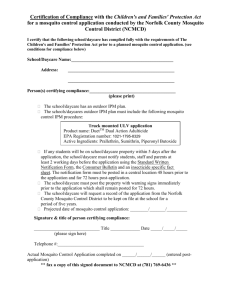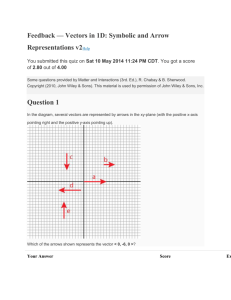OPR Technical Advisory is Urgently Needed to Raise Awareness of
advertisement

Internal Draft – Not for Distribution OPR Technical Advisory is Urgently Needed to Raise Awareness of Public Health Vector-Borne Disease Prevention Measures: Provides Cost Benefits for Developers, Natural Resources and Californians Issue: Current CEQA Statutes and Guidelines neglect to specifically address public health pests and provide protections from mosquitoes and other important public health vectors. This is a costly mistake that has led to an avoidable proliferation of project sites that breed mosquitoes and expose Californians, domestic animals, pets and wildlife to risk of diseases including West Nile virus. Some sites also provide harborage for other vectors and nuisance pests, including flies and rodents. This oversight has resulted in projects that fail to meet the design or land use objectives necessary for compliance with Section 2000 of the California Health and Safety Code (HSC). As a result, these non-compliant projects needlessly put the public, sensitive wildlife, water quality, and other resources at greater risk, increase pesticide use and frequency, increase liability of project proponents, necessitating costly retrofits, interventions and fines to property owners, and disproportionately burden taxpayers. Until a permanent CEQA fix can be accomplished to correct this oversight it is imperative that land use officials, professional planners, CEQA practitioners be informed of the need to incorporate public health vector-borne disease prevention measures that will protect the public, preserve natural resources, and reduces costs and liabilities to project proponents. Background: A vast number of mosquito and vector breeding places that exist in California can be attributed to a correctable oversight in the CEQA Statutes and Guidelines. California’s approach to water use, wetlands management and pest control has changed dramatically through the decades since CEQA’s enactment in 1970. Significant impacts to citizens, the environment, and the economy have resulted from public health mosquito and vector control considerations being largely overlooked in the planning and environmental project review and approval processes. Earlier awareness could have saved lives and money, reduced pesticide use, and ensured better protection of natural resources. For example, countless water-holding features and devices have been engineered and installed in the last 20 years to manage stormwater discharges without applying basic knowledge of vector ecology. Many poorly designed or inadequately maintained mitigation sites have unintentionally become significant sources of mosquito production, adversely impacting communities, businesses and recreational open spaces. These have also disrupted the balance and diversity of natural environments. Had these projects considered the long-term implications of mosquito production in the planning, design, and maintenance objectives at the onset, these deleterious impacts would have been largely avoided at little or no cost to the project proponent. Instead this oversight has cost developers, property owners, municipalities, public land trusts, and all taxpayers an incalculable amount of money in expensive remediation and retrofits, fines and fees due to violations of the HSC, been a drain on public resources that fund vector control services, and contributed to increased healthcare costs. Internal Draft – Not for Distribution Discussion: Issuance of a Technical Advisory by the Governor’s Office of Planning and Research (OPR) will assist project planners to minimize or avoid mosquito and vector production in CEQA approved projects. This is increasingly essential in light of tightened pesticide regulations, the encroachment of development into wetlands and wild lands, on-site water retention required by Low Impact Development standards (LID) and greywater recycling and water conservation efforts. It is also recognized that climate change will further enhance the spread of vectors and increase the outbreak of vector-borne diseases. The failure to properly address this critical concern within the CEQA Statutes and Guidelines has resulted in following problems: Problem 1: Increased urbanization brings mosquitoes closer to where people live and work. Hardscape environments force everyday urban runoff water to pool and stagnate in structures designed to convey storm flows and filter out pollutants. Many of these systems are old and in disrepair, especially gutters, retention basins and underground storm drain systems (USDS). Urban runoff from landscape and agriculture irrigation occurs year-round and increases in warmer months. These discharges stagnate and create favorable mosquito breeding conditions. The dispersal of blood-feeding mosquitoes increases the risk factor for humans, domestic animals, and wildlife for infection with diseases like West Nile virus. Solution: When new or redevelopment projects undergo a CEQA review, consideration should be given to the project’s potential to produce mosquitoes or other vectors and nuisance pests in 1) stormwater treatment/conveyance structures, 2) resulting year-round runoff flows from the project, and 3) any other features (like ornamental lakes or creeks) designed to hold or convey water. Section 2060 Article 5 (b) of the HSC states; The person or agency claiming ownership or title, or right to property or who controls the diversion, delivery, conveyance, or flow of water shall be responsible for the abatement of a public nuisance that is caused by, or as a result of, that property or the diversion, delivery, conveyance, or control of that water. A public nuisance is in the HSC Section 2002 is defined as: (j) Public nuisance" means any of the following: (1) Any property, excluding water that has been artificially altered from its natural condition so that it now supports the development, attraction, or harborage of vectors. The presence of vectors in their developmental stages on a property is prima facie evidence that the property is a public nuisance. (2) Any water that is a breeding place for vectors. The presence of vectors in their developmental stages in the water is prima facie evidence that the water is a public nuisance. (3) Any activity that supports the development, attraction, or harborage of vectors, or that facilitates the introduction or spread of vectors. Internal Draft – Not for Distribution This law establishes that the property and/or water rights owner is responsible for conditions that support a “public nuisance.” Therefore, it is imperative to evaluate the potential of a proposed project to create or prevent such a nuisance. Under most circumstances production of mosquitoes, other vectors, and nuisance pests can be avoided or minimized through proper planning and design or maintenance elements. The CEQA review process should require the project proponent to examine public health mosquito and vector control specifically, seek the advice of vector control scientists if necessary and mitigate for any significant impacts. Since currently there is no such requirement and little to no awareness of this issue the need for an OPR Technical Advisory alerting project proponents and planners is critical. Problem 2: Under NPDES permits, storm water best management practices (BMPs) and LID features are mandated to improve water quality. Most often these treatment control features and/or devices are designed to retain or infiltrate stormwater. Certain types like vortex separators, media filter chambers, treatment wetlands, underground storage tanks/systems, and rain barrels hold water for extended periods, creating ideal mosquito breeding conditions, especially if not routinely maintained. Most new projects install these BMP/LID systems ranging from a couple to hundreds depending on the scope of the project. Any given county has thousands of these features on-line today with many more in the planning phases. The sheer number of these features and devices, lack of location data, lack of public awareness, and often lack of owner awareness of the potential for mosquito breeding in them makes their inspection and treatment a complex and increasing challenge for public health mosquito and vector control programs. The few inches of highly organic standing water in many of these systems can produce thousands mosquitoes within seven days in warm conditions. Solution: Few Multiple Separate Stormwater Sewer System (MS4) permits have requirements that address mosquito and vector production from these systems and in those that do, the language and requirements are quite variable. A Technical Advisory would allow for increased awareness of this unintended consequence of stormwater management. Problem 3: State and federal resource management agencies require project proponents to mitigate project impacts to natural resources like wetlands, riparian creeks, or sensitive species. This mitigation is often in the form of habitat creation to replace, at a ratio of at least 2:1, that which is impacted. Wetland/habitat mitigation sites are commonly incorporated as aesthetic elements into housing developments and commercial complexes. Created wetlands/riparian features generally have poor water quality and low species diversity, since typically they are fed by urban runoff flows directed from the development making them ideal mosquito breeding sources, often in close proximity to where people live and work. With sometimes conflicting resource agency management objectives, these sites are frequently not maintained and become filled in with sediment and overrun with invasive vegetation and pestiferous mosquitoes. These conditions make mosquito inspection and treatment difficult and may require the property owner to acquire resource agency permits to have maintenance work performed, so that access and treatments can be effective. Consequently, when effective non-chemical control options such as Internal Draft – Not for Distribution water management or vegetation reduction cannot be—or are not—used, more frequent pesticide applications may be required for to protect public health from mosquitoes and mosquito-borne diseases. Solution: If the potential for mosquito and vector production were addressed with a Technical Advisory, project planners could effectively articulate what vector production avoidance measures would be incorporated into the site design and prescribe long-term maintenance measures. This consideration at the onset of the project is highly cost-effective for the project proponent and/or property owner who otherwise has to pay for expensive remediation and large scale maintenance costs that could have been “designed out” of the project. Problem 4: Mosquito abatement and vector control programs often do not have discretionary approval/permitting authority, and are not routinely made aware of impending new projects within their jurisdictions by city/county planning or permitting departments. Often, they become aware of new mosquito breeding sources retroactively, after a complaint(s) is filed by a member of the public. Having location and type data on potential new sources would allow mosquito control agencies to keep the sites (once on-line) under surveillance for mosquito production and proactively prevent breeding problems. Solution: This is another element that can be addressed by a Technical Advisory as project planners would be made aware of these needs and directed to resources like the California Department of Public Health document, titled “Best Management Practices for Mosquito Control in California,” a manual of cost-effective integrated vector management guidelines and design parameters. Problem 5: Public health mosquito and vector control agencies need to have safe access to sites for inspection and possible treatment. Some project sites have paths and access roads that are used for multiple purposes, but most do not; such access could be readily planned into a project and integrated with project objectives. This is especially critical for large, vegetated water features. Solution: This can also be addressed by a Technical Advisory as project proponents would be made aware of these needs and directed to resources like the California Department of Public Health document, titled “Best Management Practices for Mosquito Control in California,” a manual of cost-effective integrated vector management guidelines and design parameters. Problem 6: Mosquito and vector control programs, like many other public services, face reduced revenues, expensive new regulatory burdens, risings treatment costs, increased environmental restrictions, and a variety of other liabilities that force these programs to more regularly pursue legal abatement of properties in violation of the Health and Safety Code to resolve the public nuisance and/or public health threat. In general, vector control programs, in good faith, try to work with and assist property owners until a site can be remediated. However, with growing constraints and the sheer number of increasing mosquito breeding sites like neglected swimming Internal Draft – Not for Distribution pools or unmaintained stormwater BMPs/LIDs overburdening programs, they can no longer absorb such costs and are forced to use their abatement authority, which can fine violators up to $1,000.00 per day. Solution: Mosquito and vector control issues, if elucidated in an OPR Technical Advisory, could be reduced or completely avoided in CEQA-approved projects, significantly decreasing the likelihood of any violation of the Health and Safety Code in the as-built condition. Problem 7: Mosquito and vector control programs have long followed the principles of Integrated Pest Management, recently adopting the term “Integrated Vector Management,” or IVM. The IVM approach looks at all available options to manage mosquito and vector populations, and integrates the most effective options to protect public health. A key component of an effective IVM program is to prevent or minimize the need for ongoing control efforts, which reduces the amount of pesticide that is applied. Today, less pesticide would be used if more existing projects had considered mosquito and vector control issues during the design phase. Solution: The pesticide load into the environment could be reduced by the incorporation of mosquito and vector control considerations projects subject to CEQA review once the issue is raised with a Technical Advisory by OPR . This would help preserve water quality by reducing or eliminating features/conditions of proposed projects that would likely result in vector problems through proper planning, design, maintenance, or appropriate mitigation measures. Problem 8: The Centers for Disease Control reported that 2012 was the second highest year on record in the United States for West Nile virus human cases with 5,245 reported cases to date; 51% of these patients had the neuroinvasive form of the disease, and many will endure longlasting or permanent neurological impairment as a consequence of their illness. According to a 2006 study that examined the cost-effectiveness of a West Nile virus vaccine, the estimated baseline cost of a neuroinvasive disease was $27,500, and for each infection that resulted in a long-term disability, the cost averaged $210,000. The costs associated with each WN virus infection includes health care, lost wages, loss of productivity, and other significant economic ramifications. Solution: Reducing the number of potential mosquito and vector breeding sources through costeffective planning measures may reduce the number of human disease cases and reduce healthcare and other cost burdens both public and private. Needed Action: Discussing mosquito and vector control considerations as a preventive planning measure in an OPR Technical Advisory will begin to help address the aforementioned problems with more Internal Draft – Not for Distribution consistency to better protect the Californian’s from vectors and vector-borne diseases, reduce costs for project proponents and property owners, and save tax-payer resources. The Technical Advisory should make reference to the California Department of Public Health document, titled “Best Management Practices for Mosquito Control in California,” a manual of cost-effective integrated vector management guidelines and design parameters which serve as technical guidance for land use officials, professional planners, CEQA practitioners to address these concerns.





